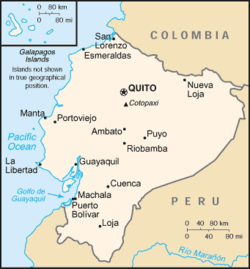Water supply and sanitation in Ecuador
Significant increases in coverage in urban areas were achieved both by the public utility EMAAP-Q, serving the capital Quito, and the private concessionaire Interagua in the country's largest city Guayaquil.
[4] Between 1965 and 1992, the Instituto Ecuatoriano de Obras Sanitarias (IEOS) or Ecuadorian Institute for Sanitary Works had been responsible for water supply and sanitation services in Ecuador.
However, there is no clear definition of roles and responsibilities between various national and sub-national actors, nor is there an independent regulator of water supply and sanitation services.
While Ecuador has a National Water and Sanitation Policy, Política Nacional de Agua y Saneamiento under Executive Decree No.
2766 of 30 July 2002 it is set out in relatively vague terms and avoids a clear position on sensitive issues such as investment subsidies (by national and sub-national governments) and who should receive them.
A draft plan for a Water and Sanitation Sector Law was prepared, but has not yet been presented to Congress, given unstable political conditions.
[4] A study commissioned by the government under financing by the World Bank concluded that nationwide, tariffs covered only about 2/3 of system operation and maintenance costs in 2001.
National and sub-national (provincial and municipal) government transfers are required to cover the operation and maintenance gap and to finance coverage expansion.
[12] Financing for urban and rural water supply investments is provided by a multitude of national and sub-national actors under different terms and conditions.
The system of sub-national transfers thus provides incentives to improve both performance and more sustainable institutional arrangements at the local level.
was at only US$2.1[14] Compared to other Latin American states like its neighboring countries Peru and Colombia, the investment level in Ecuador is low.
Families were able to consume twice as much water while paying one fifth of what they paid before, when they bought it from vendors distributing it in tankers and charging $3.50 per cubic meter.
[24] The Ecuadorian government receives external support from several donors in terms of investment and technical assistance in water supply and sanitation.
[25] Since 2001, the Proyecto de Agua Potable y Saneamiento para Comunidades Rurales y Pequeños Municipios (PRAGUAS or Rural and Small Towns Water Supply and Sanitation Project) became the government's primary instrument to face the sector's challenges, influencing key options about policy (see above), extending coverage and giving incentives to improve quality, efficiency and cost recovery of the service.
[26][27] To satisfy requirements of quality, efficiency and cost recovery, PRAGUAS offers technical assistance and financial incentives to municipalities which are interested in delegating water supply and sanitation to autonomous operators, such as public or private utilities, cooperatives etc.
As designs for more than 600,000 inhabitants (which is 13% of the Ecuadorian rural population) had already been prepared, a fast coverage expansion was expected within PRAGUAS II, which began in 2007 and lasted until 2011.
14 have completed the transition process, exceeding the aim of APL-1 (Adaptable Program Loan) of five municipalities, which was established by the World Bank and the national government in 2000.
PRAGUAS II is expected to provide the following benefits: i) support for consolidating the framework of incentives for investments in water supply and sanitation, as well as technical assistance to present a Water Law to the congress and the relevant regulations for its application; ii) A group of complementary activities to extend coverage under a demand-driven approach, enhancing hygiene benefits due to the new infrastructure and offering support to water boards aimed at strengthening the system's sustainability; iii) technical assistance and investment financing to improve quality, efficiency and cost recovery of water supply and sanitation services and management of solid waste in small towns; and iv) a communication program to develop support for sector reform.
The Interamerican Development Bank supported investments in the three largest cities of the country - Quito, Guayaquil and Cuenca - through ten programs with a total amount of US$400 million.
[28] PASSE is a program of the Health Ministry for the provinces of the central sierra region, which has received a grant from the European Union.
[30] The humanitarian organization CARE is working in 15 Ecuadorian provinces, concentrating on rural areas and especially on projects close to the northern and the southern border.


